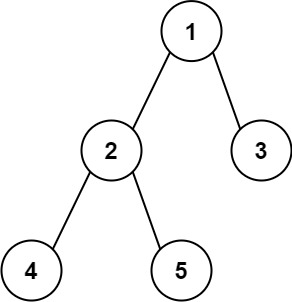Given the root of a binary tree, return the length of the diameter of the tree.
The diameter of a binary tree is the length of the longest path between any two nodes in a tree. This path may or may not pass through the root.
The length of a path between two nodes is represented by the number of edges between them.
Example 1:

Input: root = [1,2,3,4,5] Output: 3 Explanation: 3 is the length of the path [4,2,1,3] or [5,2,1,3].
Example 2:
Input: root = [1,2] Output: 1
Constraints:
[1, 104].-100 <= Node.val <= 100The core challenge of this problem is to find the longest path between any two nodes in a binary tree. This path does not necessarily have to pass through the root. The significance of this problem lies in its applications in network design, biological tree structures, and more. A common pitfall is to assume the path must pass through the root, which is not the case.
To solve this problem, we need to consider the following:
Let's start with a naive approach:
The naive approach involves calculating the height of the left and right subtrees for each node separately, which leads to a time complexity of O(n^2). This is not optimal for large trees.
We can optimize this by using a single traversal of the tree (Depth-First Search). During the traversal, we calculate the height of the subtrees and update the diameter simultaneously. This reduces the time complexity to O(n).
Here is a step-by-step breakdown of the optimized algorithm:
class TreeNode:
def __init__(self, val=0, left=None, right=None):
self.val = val
self.left = left
self.right = right
class Solution:
def diameterOfBinaryTree(self, root: TreeNode) -> int:
self.diameter = 0
def height(node):
if not node:
return 0
# Recursively find the height of the left and right subtrees
left_height = height(node.left)
right_height = height(node.right)
# Update the diameter if the path through the current node is longer
self.diameter = max(self.diameter, left_height + right_height)
# Return the height of the current node
return max(left_height, right_height) + 1
height(root)
return self.diameter
The time complexity of the optimized approach is O(n), where n is the number of nodes in the tree. This is because we traverse each node exactly once. The space complexity is O(h), where h is the height of the tree, due to the recursion stack.
Consider the following edge cases:
To test the solution comprehensively, consider the following test cases:
When approaching such problems, consider the following tips:
In this blog post, we discussed how to find the diameter of a binary tree using an optimized approach with a time complexity of O(n). We covered the problem definition, approach, algorithm, code implementation, complexity analysis, edge cases, and testing. Understanding and solving such problems is crucial for improving your problem-solving skills and preparing for technical interviews.
For further reading and practice, consider the following resources:
Our interactive tutorials and AI-assisted learning will help you master problem-solving skills and teach you the algorithms to know for coding interviews.
Start Coding for FREE